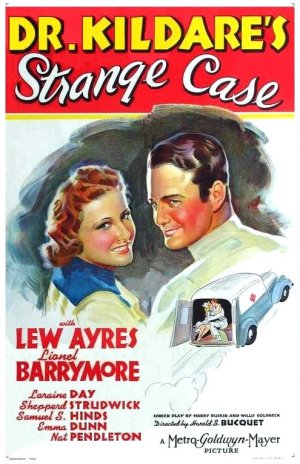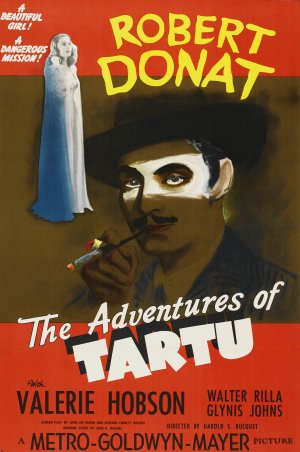The 16th film in Mill Creek’s Fabulous Forties box set was 1940’s Dr. Kildare’s Strange Case. It’s about a doctor who investigates a medical case and wow, is it ever a strange case.
Apparently, there was a whole series of Dr. Kildare films that were released in the 30s and 40s. I guess the films were the cinematic equivalent of a TV show like Grey’s Anatomy or ER or Children’s Hospital or… well, every medical show that’s ever shown up on TV since the beginning of time. Dr. James Kildare (Lew Ayres) is a passionate young doctor who may break the rules but he gets results! His mentor is Dr. Gillipsie. Gillipsie is played by Lionel Barrymore and since the character is cranky and confined to a wheelchair, it was impossible for me to watch him without thinking about Mr. Potter from It’s A Wonderful Life. Whenever Kildare went to him for advise, I kept expecting Gillipsie to glare at him and say, “You once called me a warped old man…”
Anyway, Dr. Kildare works in a hospital and, when he’s not silently judging everyone else that he works with, he’s busy silently judging the wealthy Dr. Lane (Sheppard Strudwick), a brain surgeon whose patients keep dying. Kildare and Lane are also both in love with the same nurse, Mary Lamont (Laraine Day). Mary wants to marry Kildare but Kildare would rather be poor and single than compromise his medical principles. Lane, on the other hand, sends her a box full of silk stockings. Plus, he’s rich!
Seriously, how is this even a competition? Forget Kildare and marry Lane!
Except, as I mentioned earlier, all of Lane’s patients keep dying. Is Lane incompetent or, as Kildare suggests, is it possible that brain surgery is just really, really hard? I imagine it was even harder in 1940, when this movie was being made. While Kildare and Lane are operating on brains, Dr. Gillipsie is still using leeches to suck sickness out of the poorer patients.
(You don’t actually see it happen in the movie but Gillipsie comes across as being a leech man.)
Anyway, eventually, Kildare has to cure a schizophrenic and it turns out that he can do this by putting the man into an insulin coma. As is explained in great detail, forcibly putting a patient in a coma will cause that patient’s mind to go back to a reset point. It’s kind of like how Windows sets up a restore point before doing a major update.
And that therapy sounds so crazy that you just know it had to be based in an actual practice. I checked with Wikipedia and I was not shocked to discover that apparently Insulin Shock Therapy used to be a thing!
Anyway, Kildare’s gets into a lot of trouble for putting his patient into a coma and attempting to erase a huge part of his mind. Will Kildare’s results vindicate his methods or will Gillipsie have to use leeches to suck the crazy out of the patient’s brain?
Watch the film to find out! Or don’t. Dr. Kildare’s Strange Case was directed by Harold S. Bucquet, who did a pretty good job with The Adventures of Tartu. His direction here is flat and uninspired, which only serves to make this entire film feel like an old TV show. I’m tempted to recommend the movie just because of the scene where it’s explained that insulin shock therapy causes patients to devolve so that they can re-evolve but otherwise, Dr. Kildare’s Strange Case is forgettable.
If you want to see it, you can watch it below!
Or you can just watch this classic episode of Children’s Hospital!

